
By Sara Bashah and Gregor Eberli - University of Miami Rosenstiel School of Marine and Atmospheric Science
May 4, 2017
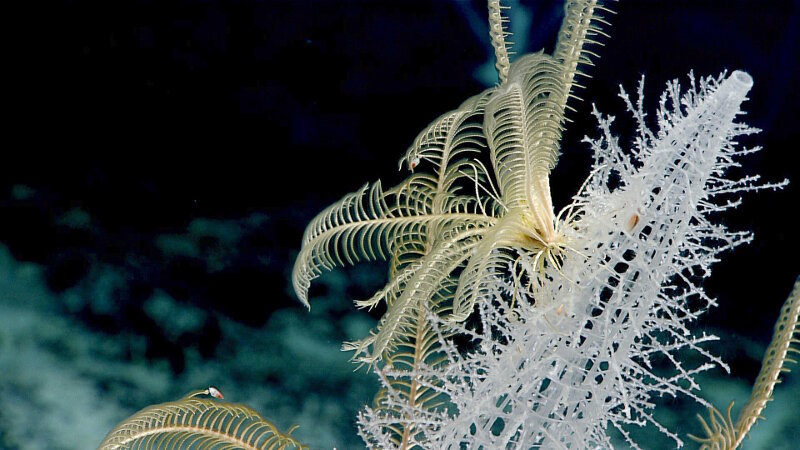
Sponge with crinoids, seen during Dive 03 of the expedition. Image courtesy of the NOAA Office of Ocean Exploration and Research, Mountains in the Deep: Exploring the Central Pacific Basin. Download larger version (jpg, 1.4 MB).
When we were invited to join the mission to the Manihiki Plateau from the Exploration Command Center (ECC) at Harbor Branch Oceanographic Institute (HBOI) at Florida Atlantic University, we were not sure what to expect. We are marine geoscientists at the University of Miami Rosenstiel School of Marine and Atmospheric Science who study marine hardgrounds and cold-water corals in the Gulf of Mexico and the Straits of Florida. This would be the first time that we had participated in a scientific cruise without actually being on the research vessel.
Soon, we discovered the great advantages of being in the ECC, and participating through telepresence. Not being burdened by shipboard duties, we could concentrate on exploring the seamounts and discussing the new findings with the scientists, both on the ship and in the ECC. At HBOI, Shirley Pomponi, Deb Glickson, Diva Amon, and the two of us could comment, debate, and educate each other about the biological and geological features transmitted from the remotely operated vehicle Deep Discoverer (D2).
During the dives, undergraduate students sat in to watch the live video streams from the seafloor and listened to all the commentary. For all of us, the dives were an exceptional learning experience – we saw how exploration science expands horizons and stimulates scientific curiosity.
Based on the fact that the Manihiki plate is 120 million years old and has experienced pelagic deposition for all this time, we expected to see a seascape of cliffs – mainly black igneous rocks (basalts) blanketed by white fine-grained pelagic sediments. However, we discovered a rocky iron-manganese crusted plateau with little sediment but abundant living organisms, including delicate cold-water corals and sponges, crinoids, brittle stars, snails, and fish. Sediment cover was limited to chutes and crevasses, although pelagic sediment must have "rained" down on the rocks for millions of years.
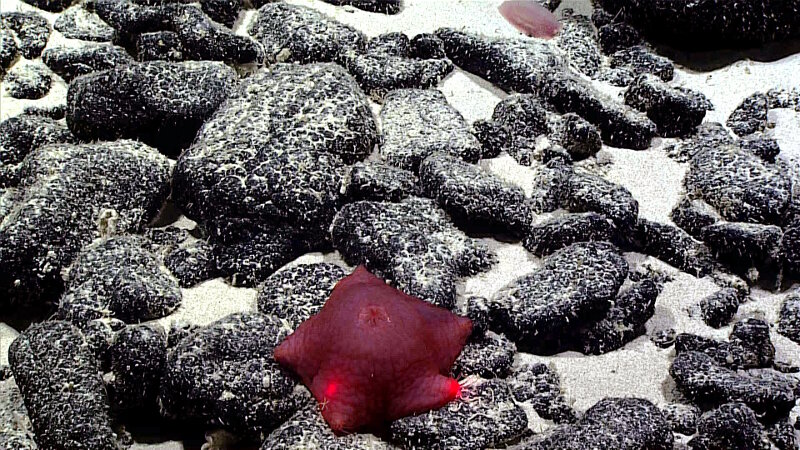
Rounded black pieces of manganese-encrusted basaltic rubble with white carbonate sand between the boulders seen on Dive 02. The red sea star is ~15 centimeters (6 inches) in diameter. Image courtesy of the NOAA Office of Ocean Exploration and Research, Mountains in the Deep: Exploring the Central Pacific Basin. Download larger version (jpg, 2.4 MB).
On April 30, 2017, Dive 02 of the expedition was conducted at nearly 2,500 meters (8,200 feet) depth on the northern Manihiki Plateau. The plateau was formed by volcanic activity approximately 125 to 120 million years ago as part of the giant Ontong Java-Manihiki-Hikuangi plateau, which is located in the southwest Pacific Ocean, north of the Solomon Islands.
Along the dive transect, the seafloor was littered with slabs and rubble of basalts – some of them rounded. All rocks were coated with a black (likely manganese) crust. Coarse sediment, sometimes rippled, was visible between, but not on, the boulders (Figure 1). This indicates that currents sweep the fine-grained sediments off the rocks, leaving the coarse-grained sediments behind.
To our surprise, the seamount harbored a viable ecosystem, including cold-water corals, sea stars, and crinoids. These organisms are obviously able to secrete a carbonate skeleton, despite the fact the water at these depths is undersaturated with respect to calcium carbonate.
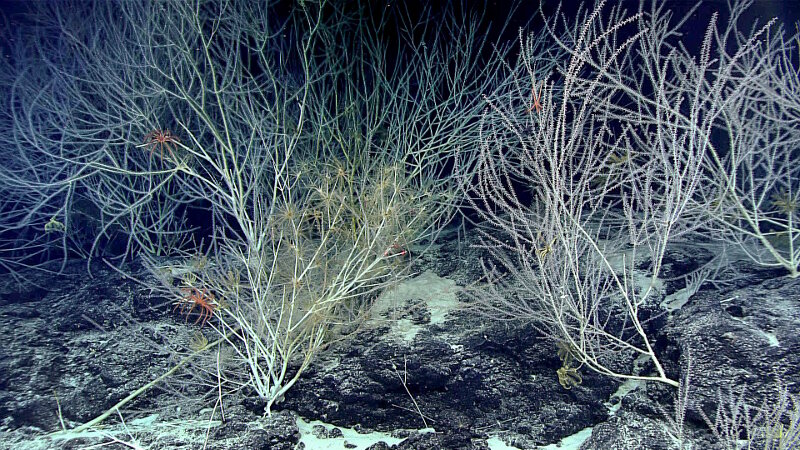
Figure 2. Thicket of bamboo corals on a rock ridge with rippled carbonate sand on both sides. The corals are habitat for crinoids, brittle stars, and squat lobster. Image courtesy of the NOAA Office of Ocean Exploration and Research, Mountains in the Deep: Exploring the Central Pacific Basin. Download larger version (jpg, 3.3 MB).
On May 2, 2017, Dive 03 of the expedition took place at Te Kawhiti a Maui Potiki, off the Cook Islands, to a depth of about 2,200 meters (7,220 feet). During the dive, D2 moved up a ridge, the habitat of an impressive ecosystem. It was a beautiful dive! The high-resolution camera captured a jungle of corals, crinoids, crabs, fishes, shrimp, sponges, and barnacles.
Most impressive during the dive was the abundance of bamboo corals, which are cold-water corals with aragonite skeletons (Figure 2). Aragonite is a calcium carbonate that can dissolve at this depth in the Pacific. The soft tissue of the corals likely prevents dissolution while the coral is alive. Once the coral is dead and the tissue decays, this protection from dissolution would be gone. This might explain why we did not observe much coral rubble around the living corals.
Sedimentary structures, such as ripples and sand waves, were very prominent along the ridge. In one spot, ripples had a fan-like pattern, indicating that the strong current was deflected by the topography of the seamounts.
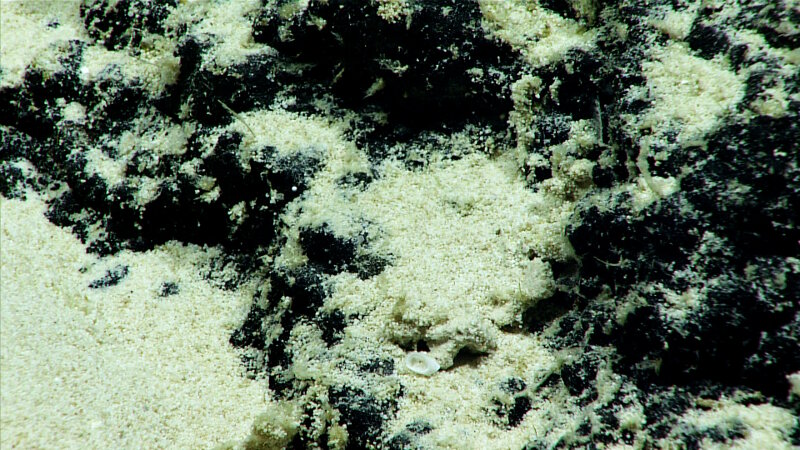
The substrate at the Dive 03 site was mostly dark, manganese-crusted rock with some soft sediment. Image courtesy of the NOAA Office of Ocean Exploration and Research, Mountains in the Deep: Exploring the Central Pacific Basin. Download larger version (jpg, 1.8 MB).
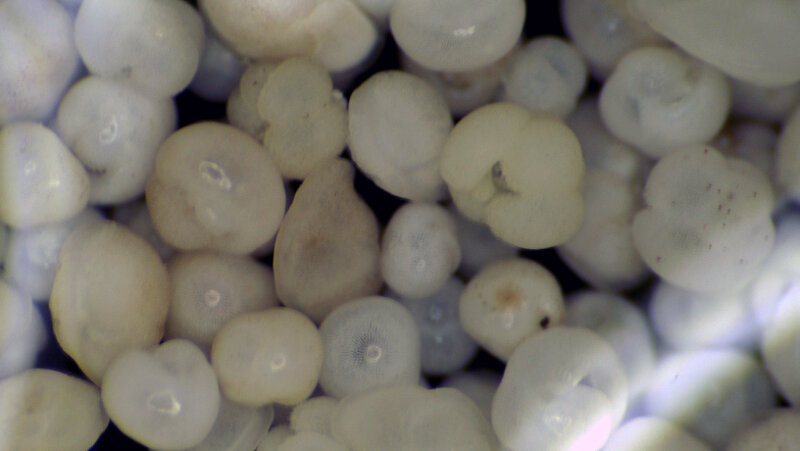
This microscope image from Dive 03 shows that the soft sediment we collected was composed of foraminifera. Image courtesy of the NOAA Office of Ocean Exploration and Research, Mountains in the Deep: Exploring the Central Pacific Basin. Download larger version (jpg, 2.5 MB).
As carbonate geologists, it was a great experience to see sedimentary processes in action in the deep ocean of the Central Pacific. Both dives show that ocean currents play an important role for corals to create colonies, and for organisms to live in a volcanic seamount ecosystem.
We thank Shirley Pomponi and the NOAA Ship Okeanos Explorer team for inviting us to participate in this cruise, and for giving us the opportunity to look at volcanic seamounts of the Pacific and their diverse deepwater fauna.